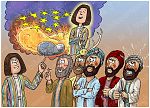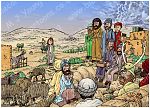Bible Cartoon: Genesis 37 - Joseph's Dreams - Scene 06 - Joseph travels to Shechem
Click on Add to cart button below shopping cart.
Purchased Bible Cartoons do not have watermarks. Links to Cartoons provided on email once purchase is completed.Bible Book: Genesis
Bible Book Code: 0103701201
Scene no: 6 of 6
Bible Reference & Cartoon Description
Genesis 37:12-17 (NLT)
12 Soon after this, Joseph’s brothers went to pasture their father’s flocks at Shechem. 13 When they had been gone for some time, Jacob said to Joseph, “Your brothers are pasturing the sheep at Shechem. Get ready, and I will send you to them.”
“I’m ready to go,” Joseph replied.
14 “Go and see how your brothers and the flocks are getting along,” Jacob said. “Then come back and bring me a report.” So Jacob sent him on his way, and Joseph traveled to Shechem from their home in the valley of Hebron. 15 When he arrived there, a man from the area noticed him wandering around the countryside. “What are you looking for?” he asked.
16 “I’m looking for my brothers,” Joseph replied. “Do you know where they are pasturing their sheep?”
17 “Yes,” the man told him. “They have moved on from here, but I heard them say, ‘Let’s go on to Dothan.’” So Joseph followed his brothers to Dothan and found them there.
DRAWING NOTES:
TIME OF DAY:
Not specified in the Bible narrative. I have set this scene in the early afternoon.
LIGHTING NOTES:
The sun (high in the sky & to the left) is strongly illuminating this scene, & casts shadows below & to the left of figures & objects.
CHARACTERS PRESENT:
On the left is the young Joseph, wearing his splendid coat. On the right is a shepherd, who is telling Joseph that his brothers have gone to Dothan, which was situated 12 miles (about 19 km) north of Shechem.
RESEARCH/ADDITIONAL NOTES:
Jacob/Israel purchased a plot of land in Shechem so it is natural that the eleven brothers (Jacob’s sons) should go there to allow their flocks to graze.
I imagine that Joseph would not have travelled in the wilderness on his own. I expect his father Jacob/Israel would have sent Joseph off to look for his brothers with a number of servants, who Jacob would have tasked with keeping Joseph safe. However, the Bible doesn’t tell us that, so I have drawn Joseph walking on his own.
This scene is set in the region of Shechem, [1] which was located 31miles (50 km) north of Jerusalem, about 28 miles (44 km) east of the Mediterranean coast, about 17 miles (27 km) west of the Jordan river & about 38 miles (62 km) south west of the southern tip of the Sea of Galilee.
Here is this scene without the figures in the foreground.

Background of Genesis 37 – Joseph’s Dreams – Scene 06 – Joseph goes to Shechem
Click on the colour bar below to view/buy this Background:
Background of Genesis 37 – Joseph’s Dreams – Scene 06 – Joseph travels to Shechem
Geology of Shechem & surrounding hills.
I looked at the geological maps of Israel to determine the nature of the region of Sheckem & its famous hills. Sheckem itself sits in an important pass (valley) which allowed passage from the west to the east, through the hills, between Mount Ebal (to the north) & Mount Gerizim (to the south). Sheckem is built on the Chalk & Marl geology of the Mount Scopus Group, a less resilient rock type than that which forms the twin mountains on either side. Mount Ebal & Mount Gerizim are formed out of the more resilient rock of the Timrat Formation, Meroz and Yizre’el Formations (Limestone, Chalk, Chert 380m).
Mount Gerizim rises about 1640 feet (500 metres) above the ancient city of Flavia Neapolis (Nablus), some 2906 feet (886 metres) above sea level. North of Mount Gerizim rises Mount Ebal, 3077 feet (938 metres) above sea level, these two mountains being the highest in the Nablus region.
[Source: https://medomed.org/featured_item/mount-gerizim-cultural-landscape-palestine/]
Plants in this picture.
At this early time in the Biblical records, I imagine that there were far more extensive woodland & forest areas covering the region than there is at present. As people spread throughout the land I imagine they cut down more & more trees for building materials & fuel, thus deforesting large swaths of the land. But at this early time in history, perhaps there were more trees in the land. For this reason I have drawn the background I the above scene more extensively wooded than the reference photo’s I used from the internet.
In the right foreground is a spiky deep purple, green & white plant, which is Moluccella spinosa (aka Spiny Molucca), a genus of annual and short-lived perennial plants native to Central & southwestern Asia and the Mediterranean. They are tall (sometimes above 2.2 feet (1 metre)), upright, branched plants with toothed leaves and small white fragrant flowers. They look interesting when dead too!
The smaller thistles in the foreground are Silybum marianum (aka Holy thistle, Our Lady’s thistle, milk thistle, blessed milkthistle, Marian thistle, Mary thistle, Saint Mary’s thistle, Mediterranean milk thistle, variegated thistle and Scotch thistle (though not to be confused with Onopordum acanthium or Cirsium vulgare). Milk thistle is an upright herb that can grow to be 12 to 79 inches (30 to 200 cm) tall and has an overall conical shape. The approximate maximum base diameter is 63 in (160 cm). The stem is grooved and may be covered in a light cottony fuzz. The largest specimens have hollow stems.
Plant symbolism.
I chose to draw thistles because of their apparent symbolism, both negative & positive.
The thistle is typically connected to negative symbolism in that the plant is often used as a metaphor for inconvenience or trouble. It symbolizes toughness, pain and aggression. In Victorian times, the thistle was known as the flower of intrusion or used as a warning against unwanted meddling.
Bearing in mind what is about to happen to poor Joseph (betrayal, imprisonment, sold into slavery at his brother’s hands!), it seemed appropriate to include the thistles as a metaphor for all his troubles!
However, the thistle is also connected to positive symbolism, in that it represents overcoming adversity and difficult situations. It is a symbol of resilience. This is appropriate when we bear in mind that Joseph comes out of his stint in an Egyptian prison (some years after this scene ) a humbled, strengthened, seasoned man, full of resilience to adversity. Incidentally, the thistle’s pink and purple colours represent nobility and royalty; which is appropriate when you consider that Joseph goes on to become the second most powerful & influential man in all of Egypt (save for Pharaoh, king of Egypt himself).
[1]
“Shechem, also spelled Shekhem, Canaanite city of ancient Palestine, near Nablus. The two locations have been closely—though erroneously—equated for almost 2,000 years: both rabbinic and early Christian literature commonly equated Nablus with ancient Shechem, and Nablus has been called Shekhem in Hebrew to the present, but Shechem’s ruins lie at a site just east of Nablus.
Shechem was important in ancient Palestine because of its position in an east-west pass between Mount Gerizim and Mount Ebal (Arabic: Jabal al-?ur and Jabal ?Aybal, respectively), one of the few such routes in Palestine’s hill country. Its ruins are under the stratified mound of Tall al-Bala?ah, just east of Nablus, which shows evidence of settlement from the Middle Bronze II period (c. 1900–c. 1750 BCE), generally associated with the time of the biblical patriarchs. In the Bible the city is first mentioned in Genesis 12:6, where, after coming into Canaan, “Abram passed…to the place at Shechem, to the oak [or terebinth] of Moreh.” Jacob bought land there, and it was the site of the rape of his daughter Dinah by the son of the local Hivite chieftain and of her brothers’ subsequent revenge (Genesis 34). The city is mentioned in Egyptian documents of the 19th century BCE. During the rule of the Hyksos kings of Egypt (16th–17th century BCE), Shechem was a strong walled city with a triple gate, a fortress-temple, and an acropolis. Some of the sites specifically mentioned in the Book of Judges have tentatively been identified by archaeologists.”
[Source: Encyclopaedia Britannica. https://www.britannica.com/place/Shechem-ancient-Canaanite-city]
Bible Doctrine Notes
37:1-17 ELECTION, God’s Promise (4.11C)
When Joseph share his dreams with his brothers he brought their wrath & hatred down upon himself. The dreams revealed God’s election of Joseph to save his family & famine-striken nations from destruction. God reveals his election promises & purposes to different people in different ways.





